Industry News, trenchless people
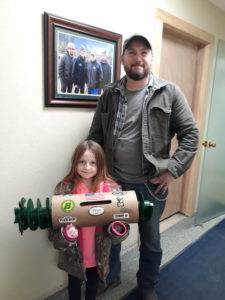
Annually, the Third Graders from East Canton Elementary School partner with area businesses to create special one of a kind Valentine’s Day card boxes. It is a great tradition that is spearheaded by Mrs. Rebecca J Carter, Principal of East Canton Elementary.
This year Third Grader Maddie Karahuta, daughter of Barbco, Inc. Maintenance Leadman, Shaun Karahuta designed an incredible box that is a miniature version of one of Barbco’s powerful, ground boring, augers!
Maddie presented this wonderful box to Barbco Co-Owner and General Manager, David Barbera recently!
This Valentine’s Day Box is proudly displayed in the Barbco, Inc. lobby!
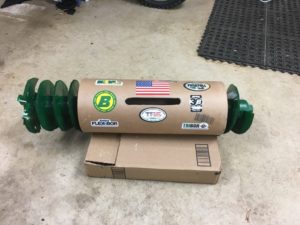
Industry News, trenchless people
 BROWNSVILLE, Wis. (April 1, 2020) — It is with profound sadness that Michels announces the passing of industry icon Robert H. Westphal on Tuesday, March 31.
BROWNSVILLE, Wis. (April 1, 2020) — It is with profound sadness that Michels announces the passing of industry icon Robert H. Westphal on Tuesday, March 31.
Bob devoted 55 years of his life to Michels, tirelessly pushing the company’s performance, and the pipeline and trenchless construction industries’ potential to higher levels. Hired by Dale Michels in April 1965 as a pipeline laborer, Bob quickly established himself as a great leader, generous mentor and valued friend to those he worked with, including the Michels family.
“It is our belief that the strength of his successors defines a leader’s true success,” said Pat Michels, President and CEO, Michels Corporation. “In that regard, Bob was the best. He was selflessly devoted to improving the abilities and skills of those who worked with him.”
“Throughout the decades, I have had the privilege of calling Bob my boss, my mentor, my colleague and my friend,” Michels said. “He had a major impact on me in each of those roles.”
In his career, Bob filled many roles, including laborer, operator, foreman, superintendent, general superintendent, vice president, senior vice president and, at the time of his death, senior construction advisor. He helped guide Michels’ development and execution of strategic business initiatives domestically and internationally.
A statesman in the construction industry, Bob was a valued member of many organizations. In 2019, he was inducted into the North American Society for Trenchless Technology (NASTT) Hall of Fame and was named Trenchless Technology Person of the Year in 2011. Bob was also an active member of the Pipe Line Contractors Association (PLCA), where he served on the Board of Directors for 13 years and as president in 2005. In 2018, he was named an Honorary Member.
Bob’s legacy will leave a significant impact on Michels and the industry he loved. We extend our thoughts and condolences to his wife, Jone; his sons Scott, Jeff, Matt and Chad; his many other family members; and his large extended family at Michels.
Industry News, trenchless products
Multiple configurations available for maximum versatility
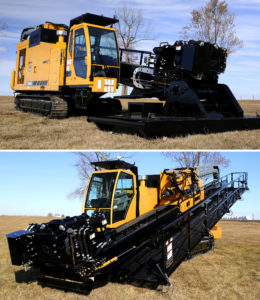 PELLA, Iowa, March 11, 2020 – Building on the success of the D220x300 S3 Navigator® horizontal directional drill (HDD), which created a new category in the HDD industry, Vermeer is setting a new standard with the D220x500 S3 Navigator® horizontal directional drill. With the ability to be configured for large-diameter water and utility installs in urban areas, as well as challenging pipeline work, the Vermeer D220x500 S3 delivers up to 54,000 foot pounds (39,828.2 Nm) of torque at a spindle speed of 36 revolutions per minute, 240,400 pounds (1069.4 kN) of thrust/pullback, and fluid flow rates of up to 350 gallons per minute (1324.9 L/min) if the onboard pump is selected. The D220x500 S3 is available with an onboard cab or stand-alone operator cab, and with a 20-foot to 30-foot (6.1-m to 9.1-m) rod rack. Contractors can also choose between a rod stager or full-length catwalk, as well as add an optional mud pump, crane or hydraulic scissor lift for optimum staging efficiency.
PELLA, Iowa, March 11, 2020 – Building on the success of the D220x300 S3 Navigator® horizontal directional drill (HDD), which created a new category in the HDD industry, Vermeer is setting a new standard with the D220x500 S3 Navigator® horizontal directional drill. With the ability to be configured for large-diameter water and utility installs in urban areas, as well as challenging pipeline work, the Vermeer D220x500 S3 delivers up to 54,000 foot pounds (39,828.2 Nm) of torque at a spindle speed of 36 revolutions per minute, 240,400 pounds (1069.4 kN) of thrust/pullback, and fluid flow rates of up to 350 gallons per minute (1324.9 L/min) if the onboard pump is selected. The D220x500 S3 is available with an onboard cab or stand-alone operator cab, and with a 20-foot to 30-foot (6.1-m to 9.1-m) rod rack. Contractors can also choose between a rod stager or full-length catwalk, as well as add an optional mud pump, crane or hydraulic scissor lift for optimum staging efficiency.
“The new D220x500 S3 integrates many of the quality features found on the Vermeer D220x300 S3 HDD, but with even more versatility and ramped-up performance,” said Tod Michael, product manager of trenchless products for Vermeer. “This drill is designed to meet the needs of utility contractors performing large-diameter city work, as well as pipeliners that are performing long, large-diameter bores.”
Choose the configuration
Outfitting the Vermeer D220x500 S3 with a 30-foot (9.1-m) rack gives crews the ability to use a variety of Range 2 drill pipe at various diameters and a range of 29 feet to 32 feet (8.3 m to 9.8 m) in length — an ideal setup for performing pipeline work. This rack configuration can be paired with a rod stager that holds four rods or a full-length catwalk. Crews will also like the benefits of using the optional hydraulic scissor lift with the rod stager to help reduce drill rod and wireline staging cycle times. Also, if paired with a stand-alone pump, the D220x500 S3, with its four 1.5-inch (3.8-cm) mudlines and 3-inch (7.6-cm) head shaft, can accommodate 650 gallons per minute (2460.5 L/min) of downhole drilling fluid flow.
For more mobile operations, the D220x500 S3 can be equipped with an on-board excavator-style cab that has a view of the open-top vises, as well as the rack and rod stager. Both the on-board and detached cab include the same dual multifunction joystick controls found on all Vermeer S3 horizontal directional drills.
Jobsite performance
The Vermeer D220x500 S3 is built with a 415-horsepower (310-kW) Cat C13 ACERT Tier 4 Final engine that is convenient to service. The drill also runs quiet at just 81.2 dB(A).
“The combination of the D220x500 S3 drill’s class-leading rotary torque and fluid pressure delivers optimized drilling and reaming performance in challenging ground conditions like rock,” added Michael. “More torque helps reduce the number of reamer passes crews need to make when widening a hole, and high fluid flow help protect tooling while maintaining the drill hole integrity and operational efficiencies.”
The D220x500 S3 also features a sliding vise that helps clamp the rod connection at different positions when reaming and pulling product, and includes a wireless remote for repositioning plus mounted cameras near the drive chuck, vise and rod handling areas for outstanding operator visibility.
For more information about the full line of pipeline horizontal directional drills, contact your local Vermeer dealer or visit vermeer.com.
Industry News, trenchless people
 CLEVELAND, OH. — With the departure of Matthew Izzard as Vice Chair of ISTT, the society’s Executive Sub-Committee (ESC) has elected Dr. Kimberlie Staheli as interim Vice Chair. Staheli currently serves on the ESC. The interim position will be in effect until the meeting of the International Council in Malaysia in November 2020 at which a new election will be held. Staheli joins Albert Shou, currently one of two Vice Chairs for ISTT.
CLEVELAND, OH. — With the departure of Matthew Izzard as Vice Chair of ISTT, the society’s Executive Sub-Committee (ESC) has elected Dr. Kimberlie Staheli as interim Vice Chair. Staheli currently serves on the ESC. The interim position will be in effect until the meeting of the International Council in Malaysia in November 2020 at which a new election will be held. Staheli joins Albert Shou, currently one of two Vice Chairs for ISTT.
Dr. Staheli stated, “I am proud and honored to be elected to the position and look forward to continuing working towards the ISTT mission of developing trenchless technology around the world.”
Kim has a B.S. in Mechanical Engineering from Rensselaer Polytechnic Institute, a M.S. in Civil Engineering from Mississippi State University and a Ph.D. in Geotechnical Engineering from Georgia Institute of Technology. She is the president and founder of Staheli Trenchless Consultants.
Kim has served as the Chair of the NASTT Board of Directors and currently serves on the NASTT No-Dig Show Program Committee. Kim teaches NASTT’s Introduction to Trenchless Technology, New Installations Short Course and NASTT’s New Installation Methods Good Practices Course. She is also part of the International No-Dig Organizing Committee for the 2022 show in Panama, representing NASTT which the society looks forward to supporting.
Craig Vandaelle, current Chair of the Board of Directors of NASTT stated, “We are delighted that Kim has been recognized in this way and shows the commitment NASTT has in supporting the ISTT family. Her knowledge and experience as Past Chair of NASTT and the Executive Committee of ISTT will be an asset to the organization.”
Blog, Industry News, trenchless projects
Tough TBM breaks through after navigating Faults, Karst, and More
 In January 2020, a Robbins 5.97 m (19.6 ft) diameter Main Beam TBM cleared its final hurdle when it broke through in Guangxi Province, China. The TBM excavated its first of two tunnels, an 11.9 km (7.4 mi) long conduit for Lot 1 of the North Line Water Irrigation Project, Letan Water Reservoir, Drought-Relief. The tunnel was marked by a gauntlet of challenges, from karst cavities to fault zones and water inflows. The workers on the jobsite, contractor Guangdong No. 2 Hydropower Bureau Co., Ltd., and the owner, Construction Management Bureau for the Letan Water Reservoir, had much to celebrate after completion of what is widely regarded as the most complex and longest tunnel on the North Line project.
In January 2020, a Robbins 5.97 m (19.6 ft) diameter Main Beam TBM cleared its final hurdle when it broke through in Guangxi Province, China. The TBM excavated its first of two tunnels, an 11.9 km (7.4 mi) long conduit for Lot 1 of the North Line Water Irrigation Project, Letan Water Reservoir, Drought-Relief. The tunnel was marked by a gauntlet of challenges, from karst cavities to fault zones and water inflows. The workers on the jobsite, contractor Guangdong No. 2 Hydropower Bureau Co., Ltd., and the owner, Construction Management Bureau for the Letan Water Reservoir, had much to celebrate after completion of what is widely regarded as the most complex and longest tunnel on the North Line project.
 Boring with the Robbins Main Beam TBM and continuous conveyor system began in summer 2015. “There was no precedent in this province for using a Main Beam TBM to excavate a tunnel longer than 10 km. We didn’t have relevant local experience to use for reference,” explained Yongjiu Jin, Deputy Manager of the Project for contractor Guangdong No. 2 Hydropower Bureau Co., Ltd. The machine did encounter a number of difficult geological obstacles as it bored through limestone rock, but was still able to achieve advance rates up to 40 m (130 ft) per day in good ground.
Boring with the Robbins Main Beam TBM and continuous conveyor system began in summer 2015. “There was no precedent in this province for using a Main Beam TBM to excavate a tunnel longer than 10 km. We didn’t have relevant local experience to use for reference,” explained Yongjiu Jin, Deputy Manager of the Project for contractor Guangdong No. 2 Hydropower Bureau Co., Ltd. The machine did encounter a number of difficult geological obstacles as it bored through limestone rock, but was still able to achieve advance rates up to 40 m (130 ft) per day in good ground.
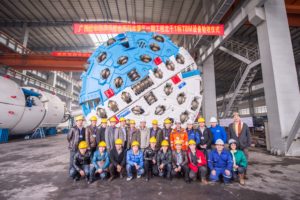 Much of the geology consisted of lightly weathered limestone in rock class II to III, with some sections in class IV to V rock that required the heaviest amount of ground support, ranging from rock bolts to ring beams and mesh. “Our team encountered a coal seam, gasses in the tunnel, two large water inrushes, three fault zones up to 103 m long, 11 karst cavities, and more. In order to solve the ground problems, there were more than 160 special technical research meetings held,” said Yongjiu.
Much of the geology consisted of lightly weathered limestone in rock class II to III, with some sections in class IV to V rock that required the heaviest amount of ground support, ranging from rock bolts to ring beams and mesh. “Our team encountered a coal seam, gasses in the tunnel, two large water inrushes, three fault zones up to 103 m long, 11 karst cavities, and more. In order to solve the ground problems, there were more than 160 special technical research meetings held,” said Yongjiu.
Throughout tunneling, the contractor expressed thanks for Robbins Field Service staff. “Robbins personnel provided good technical support from equipment installation and commissioning through to tunnel completion. After the equipment was handed over to our company, they still helped us with equipment usage on our project, which makes us very satisfied with the Robbins after-sales service. Robbins really delivered: the after-sales phase was not the end of service, but the beginning of site service,” said Yongjiu.
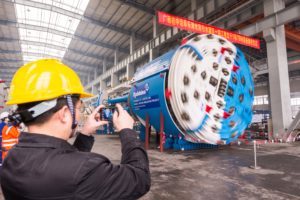 While the completion of the first tunnel—the longest single-heading construction on record for water tunnels in Guangxi—is a milestone, there is more to do. The Robbins machine will be inspected and relaunched to bore a second tunnel 4.2 km (2.6 mi) in length. The ground conditions are predicted to be equally challenging, but the tunneling operation has some help from ground prediction methodology. Tunnel Reflection Tomography (TRT)—consisting of ground prediction using seismic waves—is being used to detect changing conditions ahead of the TBM. The method can predict the distribution and scale of joints and fissures, allowing the crew to plan ahead.
While the completion of the first tunnel—the longest single-heading construction on record for water tunnels in Guangxi—is a milestone, there is more to do. The Robbins machine will be inspected and relaunched to bore a second tunnel 4.2 km (2.6 mi) in length. The ground conditions are predicted to be equally challenging, but the tunneling operation has some help from ground prediction methodology. Tunnel Reflection Tomography (TRT)—consisting of ground prediction using seismic waves—is being used to detect changing conditions ahead of the TBM. The method can predict the distribution and scale of joints and fissures, allowing the crew to plan ahead.
Located near Laibin City, the North Line project provides much needed drought relief using a network of tunnels totaling 29.4 km (18.3 mi). “This tunnel will realize the dream of drought control that people in Central Guangxi have had for many years. The breakthrough is the most important milestone event in this first phase of the North Line project,” said Yongjiu.
Image 1: Contractor Guangdong No. 2 Hydropower Bureau Co., Ltd., the project owner, and Robbins celebrate the January breakthrough of a Robbins Main Beam TBM.
Image 2: The 5.97 m (19.6 ft) Robbins TBM traversed fault zones, karst cavities, a coal seam, and more while achieving up to 40 m (130 ft) in one day.
Image 3: Robbins Field Service and Engineering staff played an important role in the project’s overall success. They advised the contractor and gave after-sales support throughout the difficult ground conditions.
Image 4: The Robbins Main Beam TBM bored through limestone rock, and installed a full range of ground support, from rock bolts to ring beams and wire mesh.
Industry News, trenchless people
New leadership leverages strengths for next level of strategic growth
 HOUSTON, March 2, 2020 /PRNewswire/ — ClockSpring|NRI, the leading high-performance critical infrastructure solutions company, today announced that Frank Firsching has been named the company’s new Chief Executive Officer (CEO) effective immediately. Firsching succeeds Matt Boucher, who is stepping down after leading the transformation of ClockSpring|NRI over the last few years.
HOUSTON, March 2, 2020 /PRNewswire/ — ClockSpring|NRI, the leading high-performance critical infrastructure solutions company, today announced that Frank Firsching has been named the company’s new Chief Executive Officer (CEO) effective immediately. Firsching succeeds Matt Boucher, who is stepping down after leading the transformation of ClockSpring|NRI over the last few years.
“We thank Matt for his leadership and laying the foundation for the success of ClockSpring|NRI, including the acquisition and integration of six companies and achievement of nearly 30 percent annualized organic growth over his tenure,” said Alex Washington, Managing Director, Wind Point Partners.
Frank Firsching brings close to 30 years of experience starting, leading and building businesses serving the oil & gas, water & wastewater, and power utility industries, with an emphasis on pipeline rehabilitation technologies over the past 15 years. Most recently, he served as the President of the $600 million Infrastructure Solutions business unit of Aegion Corporation. He was a founding partner in Underground Solutions, Inc. which was sold to Aegion in 2016. Frank spent 13 years with USFilter where he was President of the $1.0 billion Water & Wastewater Systems Group from 2001 – 2006. Frank has a B.S. Mechanical Engineering degree from the University of Virginia, an MBA from the Wharton School at the University of Pennsylvania and is the immediate past chair of the North American Society for Trenchless Technology (NASTT).
“As we look to scale the platform, Frank’s deep understanding of the technical, regulatory and commercial landscape will provide strong leadership as we continue to meet the evolving needs of infrastructure asset owners,” noted ClockSpring|NRI Board Chair, Guy Broadbent.
“ClockSpring|NRI is shaping the future of critical infrastructure renewal by delivering solutions built around high performance composite materials, specialty valves and geopolymer offerings designed to extend infrastructure asset lives while minimizing downtime, maximizing cost-effectiveness and adhering to the strictest industry safety standards,” said new CEO Frank Firsching. “I look forward to supporting the continued growth of the business and delivering value for our customers and business partners.”
About ClockSpring|NRI
ClockSpring|NRI is shaping the future of critical infrastructure through innovative composites, valves, and concrete solutions. With global headquarters in Houston, TX, the company manufactures high-performance critical infrastructure construction and repair products and provides associated engineering support and training services. ClockSpring|NRI solutions are delivered via the CSNRI, GeoTree and Advanced Valve Technologies brands and are used to construct, maintain, strengthen, protect, and rehabilitate oil, gas, and water pipelines, natural gas distribution lines, high-consequence industrial pipework, tanks, storm and sanitation assets, and civil structures. ClockSpring|NRI products are easy to install, cost-effective to deploy, and durable for decades. www.cs-nri.com
Media Contact
Judy Murray
713-419-1552
Media@CS-NRI.com










